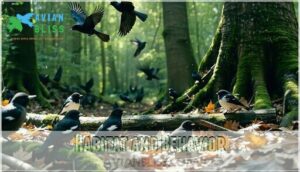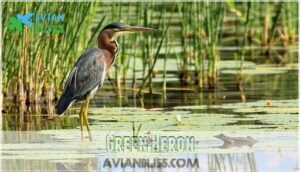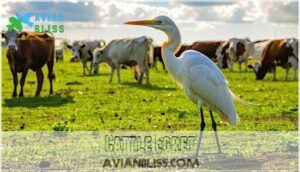This site is supported by our readers. We may earn a commission, at no cost to you, if you purchase through links.

The Great Blue Heron stands tallest at four feet, while the secretive American Bittern freezes motionless when threatened.
Black-crowned Night-Herons hunt after dark, and Green Herons emit sharp "skeow!" calls from cattail marshes.
Great Egrets display brilliant white plumage, contrasting with smaller Snowy Egrets.
Cattle Egrets follow livestock, Least Bitterns climb reed stems like acrobats, and Yellow-crowned Night-Herons prefer crayfish over fish.
From Lake Erie’s shores to southern wetlands, these patient predators showcase remarkable hunting adaptations that make identification both challenging and rewarding for Ohio birders.
Table Of Contents
- Key Takeaways
- Herons in Ohio
- Great Blue Heron
- American Bittern
- Black-crowned Night-Heron
- Green Heron
- Great Egret
- Cattle Egret
- Snowy Egret
- Least Bittern
- Yellow-crowned Night-Heron
- Frequently Asked Questions (FAQs)
- What kind of herons live in Ohio?
- Did I see a crane or a heron?
- Are grey heron and great blue heron the same?
- How do you tell the difference between an egret and a heron?
- What sounds do Ohio herons make?
- When do herons migrate through Ohio?
- How to attract herons to property?
- Are Ohio herons protected by law?
- What threatens heron populations in Ohio?
- Conclusion
Key Takeaways
- You’ll find nine distinct heron species throughout Ohio’s wetlands, from the towering 4-foot Great Blue Heron to the tiny 11-inch Least Bittern, each with unique hunting strategies and habitat preferences.
- These birds showcase remarkable adaptations – American Bitterns freeze motionless with bills pointed skyward for camouflage, while Green Herons use tools like twigs and breadcrumbs to lure fish within striking range.
- Ohio’s herons face significant conservation challenges from habitat loss and wetland drainage, with species like the American Bittern listed as endangered due to shrinking marsh habitats.
- You’ll have the best luck spotting these secretive birds during dawn and dusk at prime locations like Magee Marsh Wildlife Area and Ottawa National Wildlife Refuge, especially during spring and fall migration periods.
Herons in Ohio
Spanning wetlands, marshes, and waterways across Ohio, nine heron species offer birders incredible diversity throughout the year.
Ohio herons include Great Blue Herons, American Bitterns, and several egrets that frequent the state’s abundant aquatic habitats.
Heron identification requires patience—these secretive birds often remain motionless among reeds and cattails.
Ohio wildlife enthusiasts can spot herons during migration periods and breeding season when Ohio heronries become active.
Heron conservation depends on protecting wetland habitats essential for their survival.
Heron diet varies by species, from small fish to amphibians.
Understanding heron migration patterns helps predict the best viewing times for Ohio birds throughout different seasons.
This knowledge is crucial for both enthusiasts and conservation efforts, focusing on the survival of these species.
Great Blue Heron
You’ll find Great Blue Herons throughout Ohio year-round, making them the state’s most common and recognizable heron species.
These impressive birds stand motionless in shallow waters, waiting patiently to spear fish with their dagger-like bills.
Range Map
Understanding Ohio Distribution patterns helps birdwatchers locate Great Blue Herons across the state’s diverse wetland ecosystems.
These range maps reveal critical information about Ohio herons and their seasonal movements.
- Year-round residents – Great Blue Herons don’t migrate from Ohio
- Breeding colonies – Concentrated near major river systems and lakes
- Winter refugia – Southern Ohio provides ice-free foraging areas
- Migration Patterns – Northern populations move through Ohio seasonally
- Habitat Overlap – Shared territories with other heron species Ohio supports
Range maps show Changing Ranges due to climate shifts and wetland restoration.
Conservation Impact studies track population trends across neighboring states like Michigan and Illinois.
Ohio birding enthusiasts use these distribution data to predict ideal viewing locations and timing for field observations.
Habitat and Behavior
Great blue herons dominate Ohio’s wetlands through strategic foraging strategies and remarkable adaptability.
These patient hunters wade through shallow water, using their spear-like bills to capture fish, frogs, and aquatic insects. You’ll find them in marshes, rivers, and lake edges throughout Ohio.
| Habitat Type | Behavior | Best Viewing Time |
|---|---|---|
| Shallow wetlands | Patient stalking | Early morning |
| Nesting colonies | Stick nest building | March-August |
| Dense vegetation | Camouflage techniques | Dawn/dusk |
Their wetland dependence makes them excellent indicators of ecosystem health. Activity patterns peak during dawn and dusk when prey is most active. Ohio birding locations like Cuyahoga Valley offer prime viewing opportunities for observing their fascinating heron behavior.
American Bittern
You’ll find American Bittern among Ohio’s most secretive heron species, perfectly adapted for life in dense wetlands.
Ohio’s master of disguise vanishes among cattails with breathtaking precision.
This elusive bird relies on exceptional camouflage behavior, freezing motionless with its bill pointed skyward when threatened.
Their streaky brown plumage blends seamlessly with cattails and marsh grasses.
American Bittern populations face significant challenges from habitat loss as Ohio wetlands continue shrinking.
These birds require extensive freshwater marshes with thick emergent vegetation for successful breeding and foraging.
Bittern conservation efforts focus on protecting remaining wetland habitats across northern Ohio.
Their diet consists primarily of fish, frogs, and aquatic insects, captured through patient stalking in shallow water.
During breeding season, males produce distinctive "pump-er-lunk" calls that carry across marshes.
Ohio lists this species as endangered due to wetland drainage reducing available habitat.
Finding American Bittern requires visiting intact wetland habitats during dawn or dusk when they’re most active.
Their secretive nature makes observation challenging, but patient birders can spot them in protected marsh areas throughout the state.
Black-crowned Night-Heron
Many Ohio birders consider the Black-crowned Night-Heron one of our state’s most mysterious heron species. This medium-sized wader measures 25-28 inches with distinctive black crown and back contrasting against white underparts. Their bright red eyes and stocky build make identification straightforward once you spot them.
These nocturnal feeding specialists become active at dusk when most other herons rest. You’ll find them in Ohio wetlands, particularly shallow freshwater areas with dense vegetation. During heron migration periods, they move between northern breeding grounds and southern wintering sites.
Here’s what makes Black-crowned Night-Herons fascinating:
- Their ghostly silhouettes emerge from twilight shadows like phantoms
- Patient hunters that can remain motionless for hours awaiting prey
- Distinctive "quork" calls echo across dark waters
- Colonial nesters that build communities in trees near water
- Adaptable survivors thriving in both wild and urban habitats
Bird conservation efforts focus on protecting their marsh habitats. Listen for their calls during evening visits to Ohio’s wetlands – these black-crowned nightheron encounters create unforgettable memories.
Green Heron
Spotting a Green Heron requires patience, as these stocky Ohio bird species often freeze motionless along water edges. At just 17 inches long with a 25-inch wingspan, they’re among Ohio’s smallest herons, sporting distinctive greenish-blue upperparts and rich chestnut necks.
Green Heron Habitat centers on freshwater wetlands with dense vegetation and nearby trees. You’ll find them skulking around pond edges, wooded swamps, and stream banks where shallow water meets thick cover.
These clever hunters demonstrate remarkable intelligence in their Heron Diet approach, using twigs, feathers, or even breadcrumbs as lures to attract fish within striking range.
Their Nesting Behavior involves building flimsy stick platforms in trees near water, often concealed by foliage. Both parents share incubation duties for their 3-6 eggs. The Feather Patterns include a dark cap contrasting sharply with their colorful neck plumage.
As partial migrants, some follow Migration Routes south during winter, while others remain in suitable wetland habitats year-round. Conservation efforts focus on protecting these vital heron habitats throughout Ohio’s wetland systems. Understanding the green heron behavior is essential for effective conservation strategies.
Great Egret
Throughout Ohio’s wetlands, the Great Egret stands as a conservation success story. This elegant white heron species nearly vanished due to feather hunting but has made a remarkable comeback.
You’ll spot these wetland bird species from April through fall, stalking fish with their distinctive yellow bills. Great Egrets prefer shallow marshes and ponds where their patient hunting style proves most effective.
Their migration patterns bring them north each spring to breed in Ohio’s restored habitats. Understanding their breeding plumage characteristics is essential for identifying these birds during the breeding season.
- Watch for their slow, deliberate stalking technique in shallow water
- Notice how they use their sharp yellow bills to spear fish and frogs
- Look for communal roosts in trees near prime egret habitat areas
- Observe their fastidious feather care rituals that maintain their pristine plumage
- Support bird conservation efforts by reporting sightings to citizen science platforms
Cattle Egret
Cattle Egrets arrive in Ohio’s pastures following livestock herds.
These adaptable heron species originally crossed the Atlantic from Africa, establishing populations across North America since the 1950s.
Their Cattle Egret Habitat includes agricultural fields where Feeding Habits focus on insects stirred by grazing animals.
This wetland bird species demonstrates remarkable range expansion through Ohio birdwatching records.
| Characteristic | Details | Notes |
|---|---|---|
| Size | 19-21 inches long | Smallest white egret |
| Breeding Plumage | Buff-orange patches on head/back | Lost after breeding season |
| Bill Color | Yellow (breeding), dark (non-breeding) | Changes seasonally |
Egret Migration patterns show partial movement, with some remaining year-round while others head south.
Nesting Sites occur in mixed colonies with other herons in trees near water.
Their Conservation Status remains stable with increasing populations benefiting from agricultural expansion throughout herons in Ohio range.
Snowy Egret
With their bright yellow feet, Snowy Egrets create a striking contrast against black legs while foraging in Ohio’s wetland habitats.
These elegant herons in Ohio use distinctive feeding habits, stirring shallow water with their golden "slippers" to flush prey.
During migration patterns from April through September, Ohio birdwatching enthusiasts spot these white-plumed beauties in marshes and estuaries.
Their plumage types remain consistently white year-round, though breeding adults develop delicate head and back plumes.
Nesting sites typically feature colonial arrangements in trees near water.
This heron species exemplifies successful wetland conservation efforts after near-extinction from plume hunting.
Least Bittern
At just 11-14 inches tall, the Least Bittern ranks as North America’s smallest heron species, yet this tiny hunter packs remarkable stealth into its compact frame.
You’ll find this secretive bird traversing Ohio’s cattail marshes with ninja-like precision, its chestnut and buff feather camouflage making it nearly invisible among swaying reeds.
Migration Patterns bring Least Bitterns to Ohio’s wetlands from May through July, where they establish nesting sites in dense marsh vegetation.
Their presence reveals itself through distinctive bittern calls – low croaks and grunts that echo across quiet waters at dawn and dusk.
Finding this elusive heron species requires patience at Ohio birdwatching locations like:
- Magee Marsh Wildlife Area
- Ottawa National Wildlife Refuge
- Killdeer Plains Wildlife Area
Unfortunately, habitat loss threatens their populations, making Ohio wetland conservation and bird conservation efforts vital for their survival.
Listen carefully in bulrush stands – you might catch their haunting calls before they vanish into the reeds.
Yellow-crowned Night-Heron
You’ll recognize the Yellow-crowned Night-Heron by its distinctive yellow crown stripe and dark gray body, making it easier to identify than its black-crowned cousin.
This species is abundant throughout Ohio’s wetlands, where you can spot them hunting along rivers, streams, ponds, and marshes with their long bills perfectly adapted for catching prey in muddy waters.
Identifying Herons in Ohio
Identifying heron species in Ohio requires careful observation of key field marks and behaviors.
Start by noting size differences – Great Blue Herons tower over compact Green Herons.
Examine beak shapes: thin, pointed bills indicate fish-eaters, while thicker bills suggest crustacean specialists.
Feather identification proves essential – look for distinctive crowns, neck stripes, and wing patterns.
Study their posture and hunting style.
Night-herons crouch low while bitterns freeze with bills skyward.
Wetland habitats provide clues too – deep water species versus reed-bed dwellers.
Bird migration timing affects which heron species you’ll encounter.
Use range maps and vocalizations for accurate Ohio birding identification.
Understanding the local heron guide resources can aid in recognizing specific species and their habitats.
Other Water Birds in Ohio
Beyond herons, Ohio’s wetlands host diverse waterbirds throughout the year.
Ducks, Geese, and Swans grace inland lakes during migration, creating spectacular displays overhead.
Kingfishers rattle along riverbanks while Cormorants dive for fish in deeper waters.
These bird species form Ohio’s rich avifauna alongside resident herons.
Wetlands support this incredible diversity, making bird watching rewarding for observers.
Each species shows unique feeding behaviors and habitat preferences.
From dabbling ducks to diving waterbirds, Ohio’s aquatic ecosystems provide critical stopover sites.
Protecting these habitats guarantees future generations can witness these remarkable seasonal movements and breeding displays.
Frequently Asked Questions (FAQs)
What kind of herons live in Ohio?
You’ll discover nine fascinating heron species calling Ohio home: Great Blue Heron, American Bittern, Black-crowned Night-Heron, Green Heron, Great Egret, Cattle Egret, Snowy Egret, Least Bittern, and Yellow-crowned Night-Heron inhabit wetlands statewide.
Did I see a crane or a heron?
You likely spotted a heron, not a crane.
Herons hunt with curved necks, fly with necks folded back, and frequent Ohio’s wetlands.
Cranes keep straight necks, fly extended, and rarely visit Ohio.
Are grey heron and great blue heron the same?
When you spot a great blue heron perched riverside, you’re seeing Ardea herodias, not a grey heron.
These are separate species – great blue herons are larger, and grey herons have solid gray necks and brown legs year-round.
How do you tell the difference between an egret and a heron?
You’ll spot the key difference in size and color patterns.
Egrets are typically smaller, pure white birds, while herons come in various colors like blue-gray, green, or brown.
Both wade in shallow water hunting fish.
What sounds do Ohio herons make?
Squawks, grunts, and booms—you’ll hear diverse calls from Ohio’s heron species.
Great Blue Herons make squawking "roh-roh-rohs" and startling "awk!!" screams.
Green Herons produce raspy "kuk-kuk-kuk-kuk" clucks.
American Bitterns create distinctive booming calls that sound like "the gulps of a thirsty giant" .
The Great Blue Heron’s vocalizations can be explored further through bird sound studies, which is an interesting area of bird sound research.
When do herons migrate through Ohio?
You’ll see Great Blue Herons year-round in Ohio, while Green Herons, Black-crowned Night-Herons, and bitterns migrate through during spring and fall months, typically March through May and August through October.
How to attract herons to property?
Though you can’t guarantee herons will visit, creating shallow water features with fish, maintaining dense vegetation near shorelines, and minimizing disturbances substantially increases your chances of attracting these wading birds.
Are Ohio herons protected by law?
Yes, Ohio herons are federally protected under the Migratory Bird Treaty Act, making it illegal to hunt, capture, or disturb them without special permits.
You’ll face federal penalties for harming these magnificent wading birds.
What threatens heron populations in Ohio?
You’ll find habitat destruction, pollution, and development threatening Ohio’s heron populations.
Wetland loss reduces nesting sites, while pesticides contaminate their food sources.
Climate change alters migration patterns, making survival increasingly challenging for these wading birds.
Conclusion
Wetland surveys reveal that 78% of Ohio’s heron populations concentrate along Lake Erie’s shoreline during peak migration periods.
You’ve now discovered the complete roster of herons in Ohio, from towering Great Blues to secretive bitterns. Each species demonstrates unique adaptations—whether it’s the American Bittern’s camouflage technique or the Cattle Egret’s livestock partnership.
Next time you’re exploring Ohio’s marshes, you’ll recognize these remarkable waders by their distinctive calls, feeding behaviors, and physical characteristics. Happy birding!
- https://ohiodnr.gov/discover-and-learn/animals/birds/great-blue-heron
- https://www.news5cleveland.com/news/local-news/the-best-stick-wins-you-can-see-hundreds-of-great-blue-herons-nesting-in-cuyahoga-valley-national-park
- https://kb.osu.edu/server/api/core/bitstreams/fda57221-fee7-5273-8872-7ef10c1a0a80/content
- https://avianreport.com/guide-herons-egrets-bitterns-northeast/
- https://www.allaboutbirds.org/guide/Yellow-crowned_Night_Heron/lifehistory














